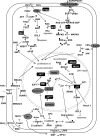Glioblastoma Multiforme Oncogenomics and Signaling Pathways
- PMID: 19777070
- PMCID: PMC2748278
- DOI: 10.4137/cmo.s1008
Glioblastoma Multiforme Oncogenomics and Signaling Pathways
Abstract
In the adult population, glioblastoma multiforme is one of the most common primary brain tumors encountered. Unfortunately, this highly malignant tumor represents over 50% of all types of primary central nervous system gliomas. The vast majority of GBMs develops quite rapidly without clinical, radiological, or morphologic evidence of a less malignant precursor lesion (primary or de novo GBMs), as compared to secondary GBMs that develop slowly by progression from diffuse low-grade astrocytomas. These GBM subtypes must be kept in mind because they may constitute distinct disease entities. Even though they look histologically quite similar, they likely involve different genetic alterations and signaling pathways. Decades of surgical therapy, radiotherapy, and chemotherapy have failed to drastically change survival. Clearly, we do not fully understand this tumor; however, the exciting genetic revolution in glioma research over the past decade is providing a promising outlook for exploring this tumor at the genetic level. Science has begun to elucidate the numerous genetic alterations and critical signaling pathways, and it has opened new exciting areas of research such as glioma stem cell biology and neoangiogenesis. This work has already begun to improve our understanding of GBM cell proliferation, migration, and invasion. Indeed, exciting novel targeted therapies are making their way to clinical trials based on this increased knowledge. This review provides the current understanding of GBM oncogenomics, signaling pathways, and glioma stem cell biology and discusses the potential new therapeutic targets on the horizon.
Figures
References
-
- CBTRUS. Statistical Report: Primary Brain Tumors in the United States. 1998–2002:2005. Central Brain Tumor Registry of the United States.
-
- Ohgaki H, et al. Genetic pathways to glioblastoma: a population-based study. Cancer Res. 2004;64(19):6892–9. - PubMed
-
- Kleihues P, Cavenee WK. WHO classification of tumors Pathology and genetics of tumors of the nervous system. Lyon: IARCpress; 2000. - PubMed
-
- Stewart LA. Chemotherapy in adult high-grade glioma: a systematic review and meta-analysis of individual patient data from 12 randomised trials. Lancet. 2002;359(9311):1011–8. - PubMed
-
- Kim DH, et al. Chromosomal abnormalities in glioblastoma multiforme tumors and glioma cell lines detected by comparative genomic hybridization. Int J Cancer. 1995;60(6):812–9. - PubMed
Grants and funding
LinkOut - more resources
Full Text Sources
Miscellaneous


